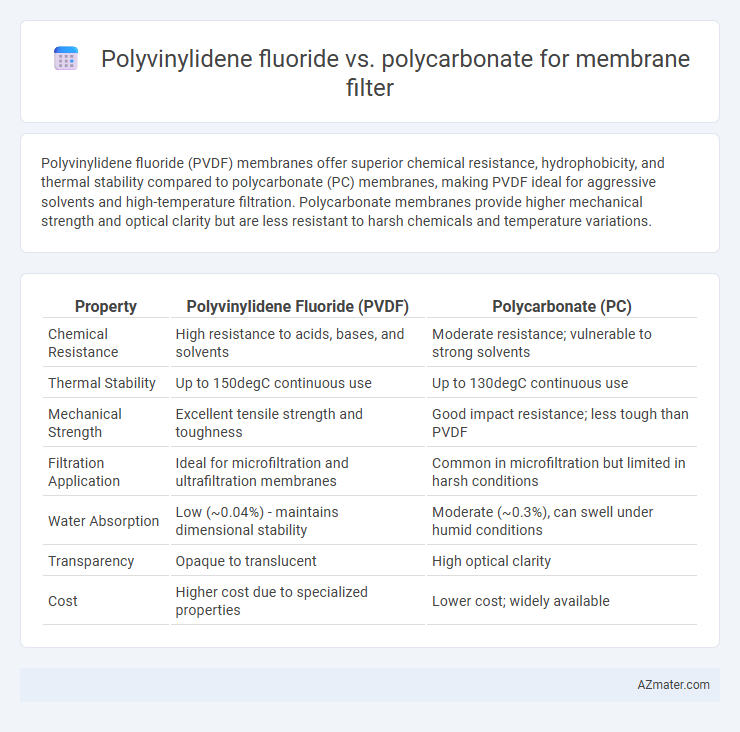Polyvinylidene fluoride (PVDF) membranes offer superior chemical resistance, hydrophobicity, and thermal stability compared to polycarbonate (PC) membranes, making PVDF ideal for aggressive solvents and high-temperature filtration. Polycarbonate membranes provide higher mechanical strength and optical clarity but are less resistant to harsh chemicals and temperature variations.
Table of Comparison
| Property | Polyvinylidene Fluoride (PVDF) | Polycarbonate (PC) |
|---|---|---|
| Chemical Resistance | High resistance to acids, bases, and solvents | Moderate resistance; vulnerable to strong solvents |
| Thermal Stability | Up to 150degC continuous use | Up to 130degC continuous use |
| Mechanical Strength | Excellent tensile strength and toughness | Good impact resistance; less tough than PVDF |
| Filtration Application | Ideal for microfiltration and ultrafiltration membranes | Common in microfiltration but limited in harsh conditions |
| Water Absorption | Low (~0.04%) - maintains dimensional stability | Moderate (~0.3%), can swell under humid conditions |
| Transparency | Opaque to translucent | High optical clarity |
| Cost | Higher cost due to specialized properties | Lower cost; widely available |
Introduction to Membrane Filters
Membrane filters are critical components in filtration systems used for separating particles and contaminants from fluids or gases. Polyvinylidene fluoride (PVDF) membranes offer excellent chemical resistance, thermal stability, and hydrophobic properties, making them ideal for aggressive chemical filtration and high-purity water applications. Polycarbonate (PC) membranes provide uniform pore size distribution and high mechanical strength, suitable for applications requiring precise particle retention and filtration consistency.
Overview of Polyvinylidene Fluoride (PVDF)
Polyvinylidene fluoride (PVDF) is a highly non-reactive and thermally stable fluoropolymer widely used in membrane filters due to its excellent chemical resistance, mechanical strength, and hydrophobic properties. PVDF membranes offer superior performance in microfiltration and ultrafiltration applications, especially in harsh chemical environments and high-temperature operations compared to polycarbonate membranes. The inherent durability and low protein-binding characteristics of PVDF make it ideal for pharmaceutical, biotechnology, and environmental filtration systems where contamination and filter integrity are critical.
Overview of Polycarbonate (PC)
Polycarbonate (PC) is a durable, transparent polymer known for its high impact resistance and thermal stability, making it suitable for various membrane filter applications. Its excellent mechanical strength and dimensional stability allow for precise pore size control, essential for consistent filtration performance. PC membranes are widely used in microfiltration and ultrafiltration processes due to their chemical resistance and ability to withstand sterilization methods.
Chemical Resistance: PVDF vs Polycarbonate
Polyvinylidene fluoride (PVDF) exhibits superior chemical resistance compared to polycarbonate (PC), making it ideal for membrane filters exposed to aggressive solvents and harsh chemicals. PVDF withstands strong acids, bases, and oxidizing agents without degradation, while polycarbonate is prone to hydrolysis and chemical attack, limiting its durability in corrosive environments. This chemical resilience of PVDF enhances membrane filter performance and longevity in industrial and laboratory applications requiring robust chemical stability.
Filtration Efficiency and Pore Structure Comparison
Polyvinylidene fluoride (PVDF) membranes demonstrate superior chemical resistance and hydrophobicity, enhancing filtration efficiency for diverse solvents and aggressive fluids compared to polycarbonate (PC) membranes. PVDF membranes typically feature a more uniform pore size distribution and higher porosity, enabling finer filtration and greater flow rates, whereas PC membranes offer precise, well-defined pore structures but with lower porosity and reduced flux. The combined attributes of PVDF membranes result in enhanced contaminant rejection and longer operational lifespan, making them preferred for high-performance filtration applications.
Mechanical Strength and Durability
Polyvinylidene fluoride (PVDF) membranes exhibit superior mechanical strength and chemical resistance compared to polycarbonate (PC) membranes, making PVDF ideal for high-stress filtration applications requiring long-term durability. PVDF's resistance to abrasion and thermal stability allows it to maintain structural integrity under aggressive operating conditions, surpassing the comparatively brittle and less chemically resistant PC membranes. Polycarbonate membranes, while offering good optical clarity and moderate mechanical strength, tend to degrade faster under harsh chemical environments, limiting their lifespan in demanding filtration settings.
Compatibility with Biological and Chemical Samples
Polyvinylidene fluoride (PVDF) membranes exhibit excellent chemical resistance and low protein binding, making them highly compatible with a wide range of biological and chemical samples, including aggressive solvents and acidic or basic solutions. Polycarbonate membranes offer superior mechanical strength and a smooth surface ideal for particle retention but may have limited chemical compatibility with harsh solvents and certain biological reagents. The choice between PVDF and polycarbonate membranes depends on the specific chemical environment and biological sample requirements, with PVDF generally preferred for biochemical assays requiring low adsorption and broad solvent compatibility.
Typical Applications in Laboratory and Industry
Polyvinylidene fluoride (PVDF) membranes excel in laboratory and industrial applications requiring high chemical resistance and thermal stability, such as protein purification, sterile filtration, and pharmaceutical processing. Polycarbonate (PC) membranes are preferred for applications demanding uniform pore size and mechanical strength, including cell culture, microbiological analysis, and particulate filtration. Both materials serve critical roles in filtration but are selected based on specific application requirements like solvent compatibility for PVDF and precise particle retention for PC.
Cost-effectiveness and Availability
Polyvinylidene fluoride (PVDF) membranes typically offer higher chemical resistance and durability, making them more suitable for aggressive filtration applications, but they come at a higher cost compared to polycarbonate (PC) membranes. Polycarbonate membranes are generally more affordable and widely available, providing cost-effective solutions for standard filtration needs with good mechanical strength and clarity. Availability of PC membranes is greater due to their broad use in laboratory and industrial settings, while PVDF membranes may require specialized suppliers, impacting overall procurement expenses.
Summary: Choosing Between PVDF and Polycarbonate Filters
Polyvinylidene fluoride (PVDF) membranes offer superior chemical resistance, thermal stability, and minimal protein binding, making them ideal for filtering aggressive solvents and biological samples. Polycarbonate filters provide uniform pore size, high flow rates, and excellent particle retention, suitable for applications requiring precise filtration and clarity, such as microbiological and analytical procedures. Selecting between PVDF and polycarbonate depends on specific needs: PVDF excels in chemical durability and low fouling, while polycarbonate is preferred for uniform pore structure and optical clarity.

Infographic: Polyvinylidene fluoride vs Polycarbonate for Membrane filter
 azmater.com
azmater.com